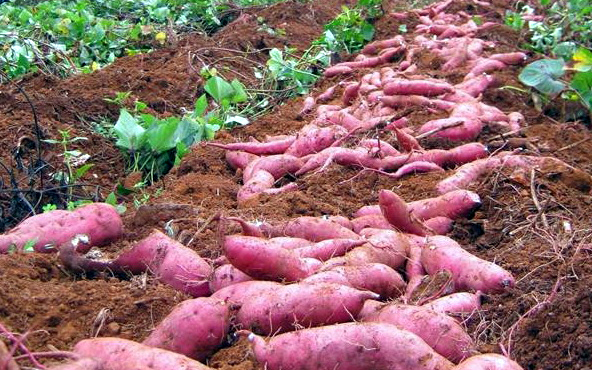Sweet potatoes are more than just a staple food for Kenyan households—they represent a significant opportunity for agribusiness. As demand continues to rise for this versatile crop, farmers across the country are exploring ways to maximize profits and tap into both local and regional markets.
In Kenya, sweet potato farming thrives in regions such as Kisii, Homa Bay, Bungoma, and parts of Central Kenya. With its minimal input requirements and resilience to varying climatic conditions, sweet potato farming has become a favorite among small-scale and commercial farmers alike.
Sweet Potato Varieties Grown in Kenya
Selecting the right variety is key to ensuring high yields and quality produce. Kenya offers several sweet potato varieties that cater to different environmental conditions and market preferences:
- SPK 004 (Kakamega): Known for its sweet taste and adaptability across regions.
- Kemb 23: High-yielding and suitable for storage and transport.
- KSP 20: Popular for its fast-growing properties and large tubers.
- Naspato: Performs well in moderate rainfall areas.
- CIP Selection: Resistant to pests and diseases, with a high yield potential.
- Tainain: A consumer favorite due to its smooth texture and rich flavor.
Choosing the right variety based on your location and target market can make a significant difference in profitability.
Ideal Conditions for Growing Sweet Potatoes
Sweet potatoes thrive in a variety of conditions, but optimal yields depend on meeting the following ecological requirements:
- Rainfall: 750-1,000 mm annually.
- Altitude: Up to 2,100 meters above sea level.
- Temperature: Above 24°C for best growth.
- Soil: Well-drained sandy loam with a pH of 5.6-6.6.
These conditions are readily available in many parts of Kenya, making sweet potato farming a viable venture for most regions.
Propagation and Planting Techniques
Sweet potatoes can be propagated using vine cuttings or storage roots. However, vine cuttings are the preferred method due to their higher disease resistance and better yield potential.
Preparing Vine Cuttings
- Select healthy, disease-free vines.
- Cut vines into lengths of 25-30 cm for planting.
- Ensure the vines have at least three nodes for optimal growth.
Planting Methods
Farmers can use two primary methods to plant sweet potatoes:
- Mound Planting
- Group 4-6 vines together in a cluster.
- Maintain uniform spacing between the clusters for consistent growth.
- Ridge Planting
- Plant a single row of vines in the middle of each ridge. Space plants 30 cm apart.
- For double rows, plant on both sides of the ridge with 30 cm spacing between plants and 50-60 cm between rows.
This structured planting ensures adequate space for tuber development and minimizes competition.
Fertilizer and Soil Management
Sweet potatoes are hardy and do not require heavy fertilization. However, enriching the soil with organic manure or well-composted farmyard manure can significantly improve yields, especially in nutrient-deficient soils.
Soil testing before planting is recommended to identify any nutrient deficiencies and address them with appropriate amendments.
Best Practices for Sweet Potato Farming
To ensure a successful harvest, farmers should implement the following farm management practices:
- Regular Weeding
- Clear weeds to prevent competition for nutrients and water.
- Use mulch to suppress weed growth and conserve soil moisture.
- Pruning
- Prune excess leaves to allow more nutrients to reach the tubers.
- Irrigation
- While sweet potatoes are drought-tolerant, timely irrigation during dry spells can boost yields.
- Pest and Disease Control
- Use organic or chemical methods to manage common pests such as sweet potato weevils and aphids.
- Rotate crops to minimize the risk of diseases like root rot and leaf spot.
Harvesting Sweet Potatoes
Sweet potatoes are ready for harvesting between 3 and 6 months after planting, depending on the variety and environmental conditions.
Methods of Harvesting
- Harvesting Leaves
- The leaves, which are rich in nutrients, can be harvested as vegetables two months after planting.
- Harvesting Tubers
- Tubers are harvested by loosening the soil and carefully pulling them out to avoid damage.
Farmers should harvest on time to prevent tubers from becoming woody and losing their quality.
Expected Yields
Under optimal conditions, a farmer can harvest between 10-20 tonnes of sweet potatoes per hectare.
Market Opportunities for Sweet Potatoes
Sweet potatoes have a strong market presence in Kenya, driven by their versatility as a food crop and their nutritional value. Farmers have several avenues for selling their produce:
- Local Markets
- Sweet potatoes are sold at local markets for Ksh 50-70 per kilogram.
- Institutional Buyers
- Schools, hospitals, and hotels provide a stable demand for bulk purchases.
- Value Addition
- Transforming sweet potatoes into flour, crisps, or baked goods offers higher profit margins and access to premium markets.
- Export Opportunities
- Neighboring countries such as Uganda, Tanzania, and Rwanda provide growing export markets for Kenyan sweet potatoes.
Challenges in Sweet Potato Farming
Despite its benefits, sweet potato farming in Kenya faces several challenges, including:
- Pests and Diseases: Weevils and fungal infections can reduce yields.
- Unpredictable Weather: Droughts or excessive rains can impact production.
- Limited Access to Planting Material: Certified disease-free vines are not always readily available.
Government and private initiatives aimed at improving access to quality vines and training on modern farming techniques are helping farmers overcome these challenges.
Sweet potato farming in Kenya is a promising venture for farmers looking to diversify their agribusinesses. With low input requirements, strong market demand, and opportunities for value addition, this crop offers substantial returns on investment.
By adopting best practices, choosing suitable varieties, and exploring new markets, farmers can unlock the full potential of sweet potato farming and contribute to food security and economic growth in Kenya.





